Hi-van is supported by its audience. When you purchase using our links, we may earn an affiliate commission (no added cost to you). Learn more
It is a well-known fact that a
Additionally, it is normal that your solar battery loses its capacity over time (5 to 6 years depending on usage), but if they’re not correctly maintained, their lifespan decrease even more quickly (could be less than a year).

Routine maintenance and properly discharging and recharging a battery will extend your van solar battery’s lifespan. Keep an eye on the ambient temperature as well; really low and high temperatures could damage your installation. These are the 2 most impactful elements to keep an eye on, but here is a list of all the different actions you can take to extend the life of your van solar battery system:
- Invest in a good battery (lithium type battery has the biggest lifespan)
- Get a good Battery Management System (BMS)
- Properly wire your system
- Respect the correct discharge rate for your battery
- Avoid corrosion and heat
- Regularly clean your battery terminals
- Properly store your van solar battery during winter
- Regularly charge it while not in used
In this article, we’ll explain each way in more detail to give you all the knowledge needed to avoid damaging your solar system battery.
What is the lifespan of solar batteries?
The first question that most people ask about a solar system is how long do solar batteries last? Indeed, most of the time, batteries represent the biggest investment in a solar system. So you want them to last as long as possible.
The answer to that question is different for each type of battery and the usage you made out of it. Hopefully, here’s a great resume and comparison table made by Mozaw.com. The lifespan of a battery depends heavily on the number of cycles it can handle before losing its energy storage capacity.

I personally went for a 12.8v lithium battery with a big DoP (depth of discharge) by Victron, more info here. Lithium-ion batteries are a great solution for van life. They’re lighter, can be completed discharged, and their number of cycles (One cycle represents the process of charging a rechargeable battery and discharging it) is generally much higher.
Invest in a Good Battery
As you can see in the comparison table, not all battery types are made equal. Lithium-ion is the battery chemistry type that has the biggest lifespan. It requires a high upfront cost, but it’s an investment that will be quickly offset by long-term cost-effectiveness.
Here are three great batteries made by well-known and respected manufacturers:

Battle Born LiFePO4 Deep Cycle Battery: founded in 2013 by two MBA students in their garage, Battle Born Batteries harnesses the power of lithium iron phosphate (LiFePO4) and sells today one of the best solar batteries available on the market. Their batteries are made in Nevada, USA, and are engineered and designed to last. This 100Ah 12v with Built-In BMS battery by Battle Born is rated to last between 3000 and 5000 Deep Cycles.
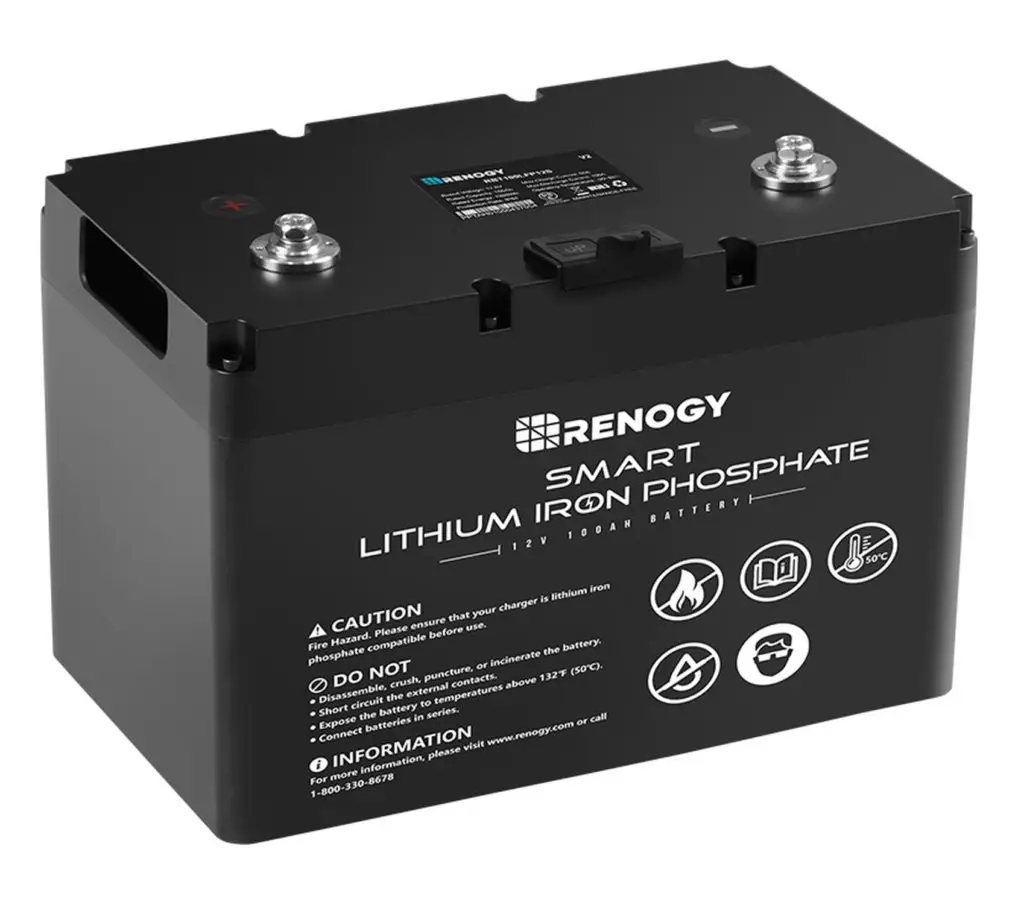
Renogy 12V 100Ah Smart Lithium Iron Phosphate Battery: Founded in 2010, Renogy has been on a mission to change the way the world uses energy. They want to make sustainable living and energy independence more affordable and cost-efficient. They produce all types of solar-related products, and this smart lithium battery has a great BMS integrated and a lifespan of more than 4000 cycles.

AIMS Lithium Battery 12V 100Ah LiFePO4: Founded in Nevada back in 2001 by founder and president Bruce de Jong, AIMS was firstly making inverters. They’re now well-known in the deep-cycle battery business. They carry an extensive selection of AGM and lithium deep cycle batteries and accessories. For example, this 100Ah lithium battery has a high number of charge/discharge cycles ( more than 4000), and it can operate at a wide temperature range.
Get a Good Battery Management System (BMS)
A BMS is a key part of the life of your battery. Indeed, this electronic component manages your battery and protects it from operating outside its safe operating area. More recent lithium batteries called “smart”, like the Renogy 12V 100Ah I recommended earlier, have a BMS integrated directly in their design. It comes in really handy and ensures you have a battery correctly charged and discharged. You don’t want to overcharge your solar battery by putting too much electricity in your battery, or you’ll kill it.
Then, a Monitoring Screen works hands to hands with a smart battery to give you all the information you need concerning your battery.
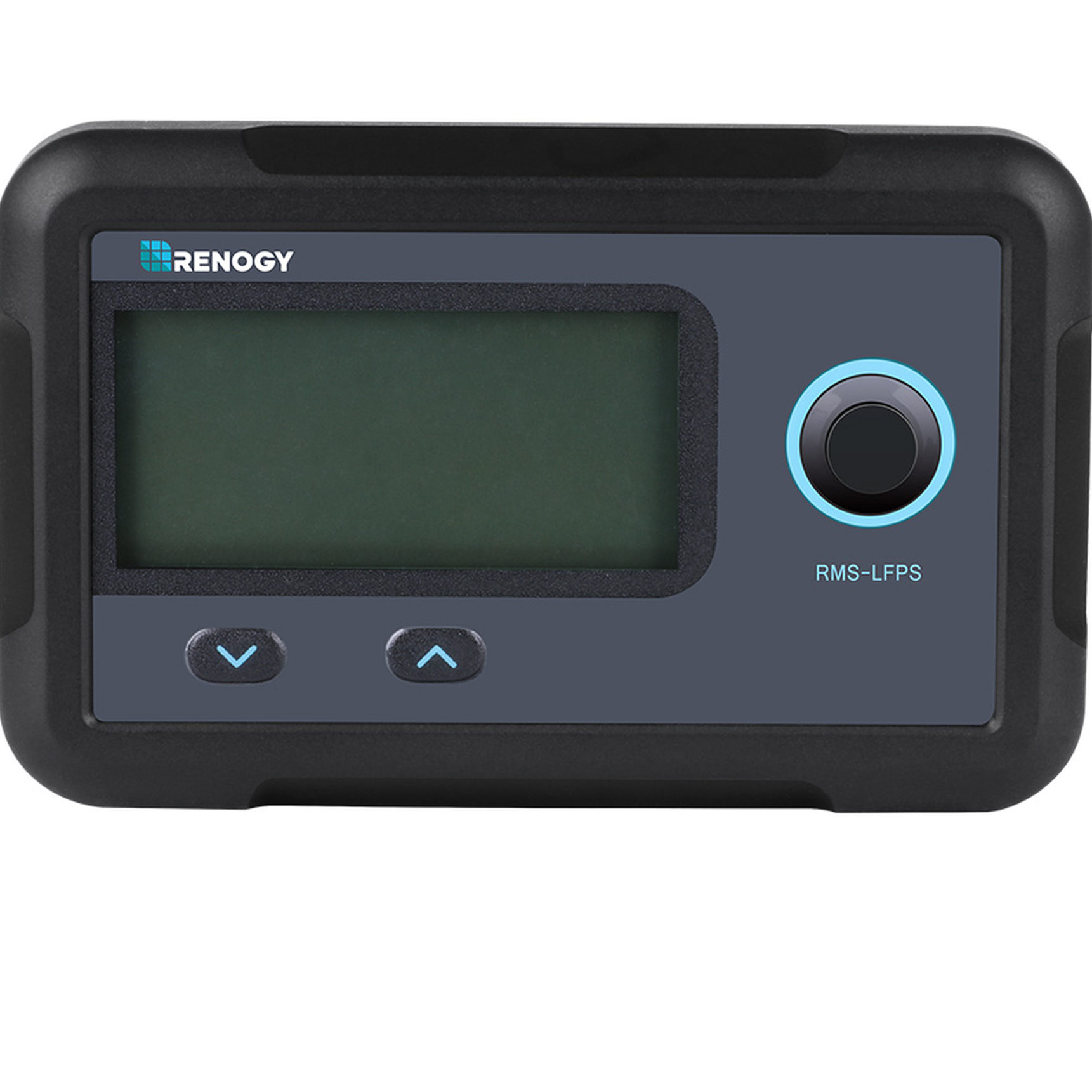
Properly Wire your Solar System
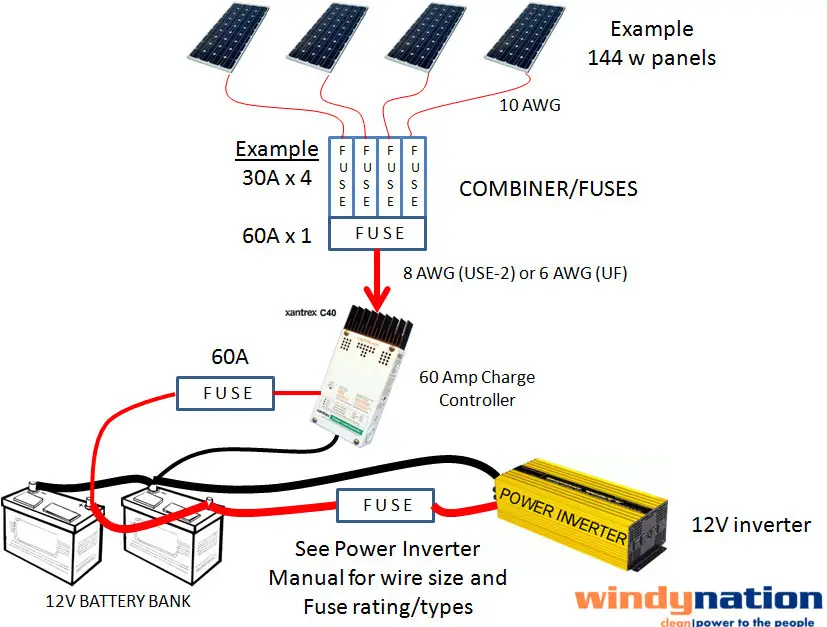
To avoid any surcharge that could severely damage your solar battery, you need to use the appropriate fuses and wires size. Furthermore, try to stay organized in the way you’re building your van. You want to easily access your electrical/solar system to see and fix any potential issues quickly. Spending hours looking for the fuse that is blown out is a complete waste of time.
You don’t want to install too small wires that can’t handle the current going through properly, or you’ll risk a surcharge and a potential fire. In addition, smaller wires will put greater stress on your battery and will for sure decrease its lifespan.
WindyNation made a great article about correctly wiring your system and how to fuse a solar system properly.
Find this content useful 🙂 ?
Subscribe to our Newsletter and get a free Solar Electric Diagram + shopping list.
Respect the Correct Discharge Rate for your Battery
More commonly called the DoD, the discharge rate represents the amount in the percentage of the energy used in a battery. In opposition, the state of charge called SoC represents in percentage the amount of energy still available in your battery. Here’s an illustration to better explain these characteristics:
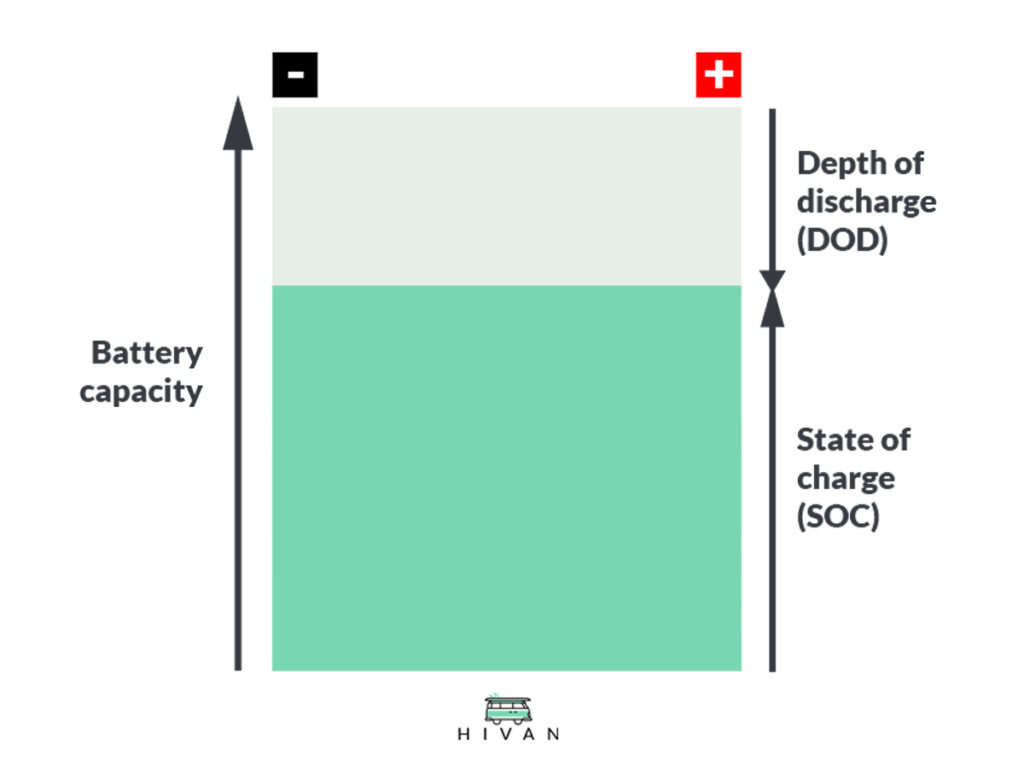
Solar batteries are made to be discharged daily and can endure slow charges coming from solar panels.
Lead-acid batteries shouldn’t be depleted under 50% of their capacity. It means you shouldn’t go for a bigger DOD than 50%; otherwise, you’ll severely reduce its lifespan. It is different for lithium-ion batteries as most of them can withstand a much bigger DOD (more than 90% sometimes).
For example, a 12V 100Ah lead-acid battery has a real capacity of 50% of 100Ah, which equals about 50Ah, compared to the same battery made out of lithium, which will have a usable capacity of about 80Ah and more.
Avoid Corrosion and Heat
Battery corrosion happens when hydrogen gas released from the battery acid reacts with the metal terminals and creates a strange rusty layer.
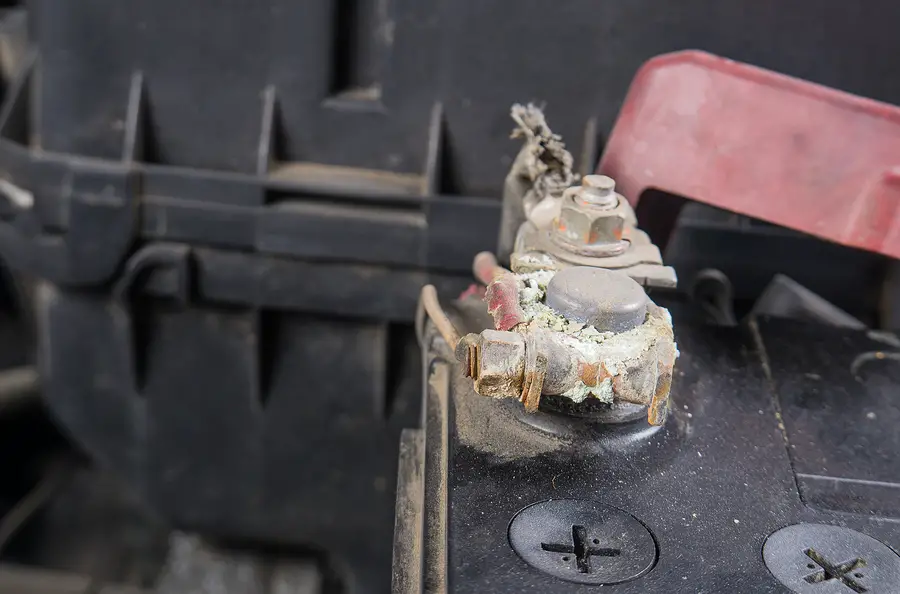
Sulfation is a different issue that happens when your flooded battery cells are not perfectly sealed anymore. Even though it looks almost the same as corrosion on your battery terminals, you should take care of it with precaution. Indeed, the white residue is toxic and shouldn’t be touched or inhale.
How to clean your battery terminals:
If you noticed that your battery terminals are covered by corrosion, use a special brush to clean them like the following:

In addition, you can use a Long-Term Corrosion Inhibitor Spray available on Amazon.com to coat your battery terminals to protect them against rust And corrosion.
You should take the heat seriously as it can severely and quickly damage your battery. To resume, high temperatures will alter the chemical reactions happening inside your battery and damage it. UPS battery center made an article about it here if you’d like to learn more about the subject.
To combat heat issues, make sure your RV doesn’t stay in scorching areas for too long. Then, you can also install a vent near your battery bank to get air flowing, therefore reducing the heat by one or two degrees.
If your battery terminals are dirty or covered by corrosion, your battery will need to deliver more energy than required to pass through them. In the long run, this unnecessary stress will reduce your battery lifespan. Therefore, cleaning them 3 to 4 times a year is a good idea. It doesn’t take time to do it with this special brush and allows you to see any issue regarding your battery bank.
The same goes for the area where you store your battery. Don’t hesitate to clean any piece of dust and dirt. It should stay clean and a minimum protected from the outside environment.
Properly Store your Van Solar Battery during Winter
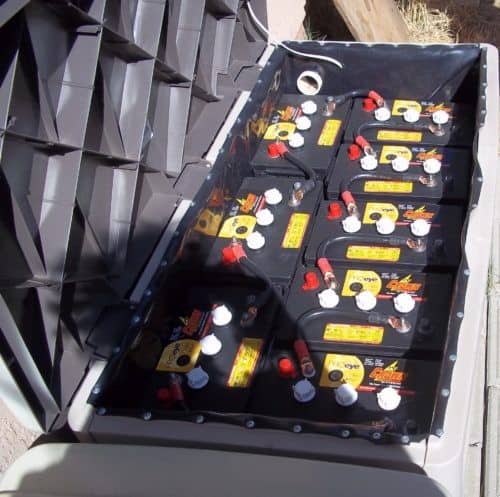
I created a complete article about this subject here.
To resume, you want to turn off your electrical system completely and, if possible, unplug your batteries as well. If you’re planning to store your van in a potentially bad environment for your battery bank, don’t hesitate to take your batteries to a dry place where the temperature is monitored.
Furthermore, you should keep an eye on the state of charge of each solar battery and charge it if necessary to avoid a complete discharge that damages your battery.
Regularly Charge your Solar Battery while not in used
A van solar battery self-discharge even when not in use. Indeed, as Panasonic explains it, a tiny amount of the chemical elements inside your battery still reacts even if the electrodes are not connected.
The speed of discharge depends mainly on the type of battery and the temperature. Lower temperatures will slow down the self-discharging, and in opposition, higher temperatures will accelerate it.
This is why you should regularly check your battery’s state of charge (SOC) if you want to extend its lifespan. Your battery shouldn’t have a lower SOC than 50%. You can check your battery SOC with tools like the Victron Battery Monitor available on Amazon.com.

This tool comes in really handy to monitor your battery state of charge and current electricity consumption. You then need to charge your solar battery whenever they’re getting near a 50% SOC.
If you can’t regularly check your battery state of charge, you can connect it to a smart charger like this Ampeak Charger that will take care of it automatically. It is important to choose a smart charger that can handle your type of battery and the connection of your battery bank. For example, this Ampeak Charger can not take care of battery banks connected in parallel and made out of lithium-ion batteries.
If you have a lithium battery, I recommend this Aimtom Smart Charger that fits lead-acid and LiFoPo (lithium) batteries. It’s a simple and practical charger made especially for vehicle batteries (RV, motorcycle, trucks, SUV, etc.)
Final Words
It is important to know how to take care of your van solar battery. Their usage and storage can greatly impact their lifespan, and you don’t want to kill your battery after your first week of van life. If you understand how a battery works and what you should do to keep it safe, it can generally last for many years.
To resume, the most important element to keep in mind is how your battery charge and discharge. You should carefully read the manufacturer’s manual to get all the information you need regarding this subject. While you read it, you should also look at the recommended working temperatures and storage conditions.

